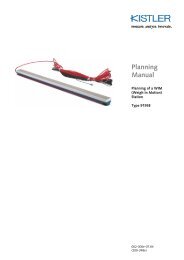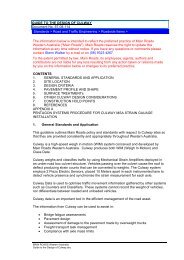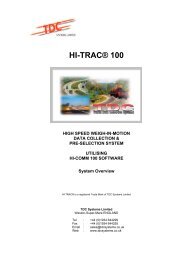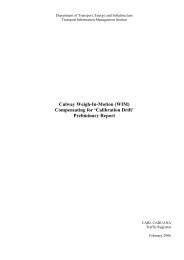AP-G84/04 Best practice in road use data collection, analysis ... - WIM
AP-G84/04 Best practice in road use data collection, analysis ... - WIM
AP-G84/04 Best practice in road use data collection, analysis ... - WIM
Create successful ePaper yourself
Turn your PDF publications into a flip-book with our unique Google optimized e-Paper software.
Accessed by AR - ARRB TRANSPORT RESEARCH on <strong>04</strong> Feb 2005<br />
4 TRAFFIC COUNTING PROGRAM<br />
Aust<strong>road</strong>s 20<strong>04</strong><br />
— 13 —<br />
<strong>Best</strong> Practices <strong>in</strong> Road Use Data Collection, Analysis and Report<strong>in</strong>g<br />
This section addresses best <strong>practice</strong>s <strong>in</strong> a traffic count<strong>in</strong>g program. It beg<strong>in</strong>s with a brief<br />
description of the current situation <strong>in</strong> traffic count<strong>in</strong>g programs amongst <strong>road</strong> authorities (RAs).<br />
The description is from the perspective of traffic count<strong>in</strong>g techniques and methods as well as from<br />
the perspective of the RAs hav<strong>in</strong>g to balance rigour <strong>in</strong> their traffic count<strong>in</strong>g programs aga<strong>in</strong>st an<br />
<strong>in</strong>creas<strong>in</strong>g rate of change and variation <strong>in</strong> traffic flows ca<strong>use</strong>d by economic activity, <strong>in</strong>creased<br />
scrut<strong>in</strong>y and <strong>use</strong>r demands as well as budgetary cost pressures (Section 4.1). This section covers<br />
best <strong>practice</strong>s <strong>in</strong> the three ma<strong>in</strong> areas of traffic count<strong>in</strong>g programs: obta<strong>in</strong><strong>in</strong>g the raw <strong>data</strong> (Section<br />
4.2), transform<strong>in</strong>g the raw <strong>data</strong> <strong>in</strong>to AADT and VKT (Section 4.3) and report<strong>in</strong>g of the raw and<br />
transformed <strong>data</strong> (Section 4.4).<br />
4.1 Background<br />
Traffic counts and classifications are the basic raw materials for the study and <strong>analysis</strong> of traffic,<br />
form<strong>in</strong>g a key <strong>in</strong>put and <strong>in</strong>fluenc<strong>in</strong>g the design, ma<strong>in</strong>tenance and management decision mak<strong>in</strong>g of<br />
every RA. In fact, the importance of traffic <strong>data</strong> extends beyond the <strong>in</strong>terests of each RA to <strong>in</strong>clude<br />
various commercial <strong>use</strong>rs (for plann<strong>in</strong>g and commercial studies) and other government agencies at<br />
a national level on policies lead<strong>in</strong>g to an <strong>in</strong>tegrated national land transport <strong>in</strong>frastructure network.<br />
In general, there are three ma<strong>in</strong> themes of traffic <strong>data</strong>:<br />
Variation of traffic flow by location,<br />
Time-variation of traffic flow,<br />
Composition of the traffic flow.<br />
The above <strong>data</strong> are collected by count<strong>in</strong>g stations. Count<strong>in</strong>g stations are located at various po<strong>in</strong>ts<br />
<strong>in</strong> the <strong>road</strong> network to ensure the <strong>collection</strong> of a representative sample of <strong>data</strong> that will, <strong>in</strong> isolation,<br />
report on particular <strong>road</strong> segments or corridors and, <strong>in</strong> aggregate, report on the entire <strong>road</strong> network<br />
itself. Two types of count<strong>in</strong>g stations are employed. They are the Permanent Count<strong>in</strong>g Stations<br />
(PCS, also known as ‘Pattern Stations’) and Short-term Count<strong>in</strong>g Stations (SCS, also known as<br />
‘Sample’ or ‘Coverage’ Stations). Pattern Stations cont<strong>in</strong>uously monitor or frequently sample traffic<br />
to determ<strong>in</strong>e patterns and seasonal fluctuations. Such stations are permanent or semi-permanent<br />
for count<strong>in</strong>g over a def<strong>in</strong>ed ‘season’ (usually a year). Short-term stations are count<strong>in</strong>g stations that<br />
are utilised for brief traffic surveys rang<strong>in</strong>g from periods of a few weeks to one hour, with a typical<br />
sample site count<strong>in</strong>g traffic for seven consecutive days.<br />
Traffic count<strong>in</strong>g faces pressure from <strong>use</strong>rs who want additional <strong>data</strong> for reports and projects, as<br />
well as from owners who want improved cost efficiencies. Out-sourc<strong>in</strong>g many aspects of <strong>data</strong><br />
<strong>collection</strong> and ma<strong>in</strong>tenance is more commonplace today and one particular traffic <strong>data</strong> unit <strong>in</strong> a RA<br />
has become totally off-budget, requir<strong>in</strong>g it to secure customers amongst the various divisions<br />
with<strong>in</strong> the parent RA.<br />
At the same time, rapid changes <strong>in</strong> the economy, the development of toll <strong>road</strong>s, <strong>in</strong>creased freight<br />
flows, chang<strong>in</strong>g vehicle regulation and technology have resulted <strong>in</strong> potentially large changes <strong>in</strong><br />
traffic patterns as well as the potential to <strong>use</strong> new technology to track and count vehicles.<br />
In this environment, it is timely to revisit the fundamentals of traffic count<strong>in</strong>g programs. The<br />
contribution of the practitioners <strong>in</strong> this field through the earlier fieldwork and the recent Aust<strong>road</strong>s<br />
Road Use Data Workshop has been <strong>in</strong>valuable towards a common sense approach <strong>in</strong> address<strong>in</strong>g<br />
and develop<strong>in</strong>g best <strong>practice</strong> for traffic count<strong>in</strong>g programs.

















